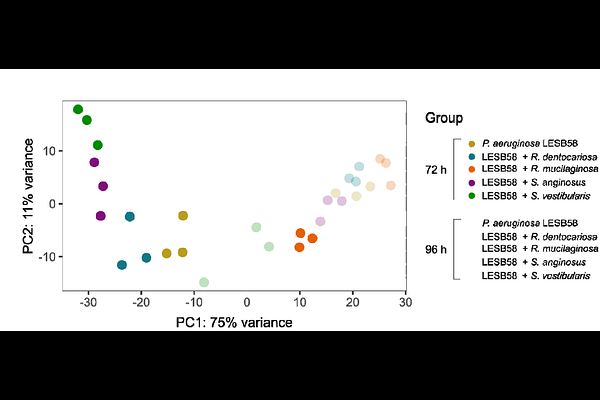Co-infection with Streptococcus and Rothia spp. drives prophage dynamics in Pseudomonas aeruginosa in an artificial sputum model

Co-infection with Streptococcus and Rothia spp. drives prophage dynamics in Pseudomonas aeruginosa in an artificial sputum model
Wright, L. L.; Cazares, A.; Figueroa, W.; Chatterley, L. C.; Willmott, T. O.; O'Brien, S.; Fothergill, J.
AbstractObjectives: Chronic bacterial lung infections with Pseudomonas aeruginosa are common in people with cystic fibrosis (CF) but interactions with other commonly seen members of the CF lung community, such as Streptococcus and Rothia spp., are not well understood. The aim of this study was to determine the impact of other species on P. aeruginosa using an artificial sputum medium (ASM) model designed to mimic the conditions in the CF lung. Methods: P. aeruginosa LESB58, representing a CF epidemic strain, was inoculated into ASM either alone or in co-culture with Streptococcus anginosus, Streptococcus vestibularis, Rothia mucilaginosa or Rothia dentocariosa. Gene expression was assessed using RNAseq at 72 and 96 h timepoints. Free phage numbers were assessed by plaque assay and qPCR. Results: Differential expression of P. aeruginosa genes, including those related to virulence factors such as prophage, type III secretion, exopolysaccharides and pyochelin production, was seen in co-culture conditions compared with single-species culture. In particular, at 72 h, there was lower expression of most LES prophage genes under co-culture conditions, and this corresponded with lower overall free phage at the same timepoint. Specifically, during co culture, there was a reduction in the levels of a D3112-like transposable phage, previously shown to have the ability to drive CF-like adaptations in an experimental evolution model, and an increase in levels of Pf1-like filamentous phage, associated with altered biofilm formation and immune responses. Conclusion: Gene expression changes during co-culture with Streptococcus and Rothia spp. were identified affecting key P. aeruginosa virulence factors including phage. Further work indicated changes to free phage levels of two important P. aeruginosa LESB58 prophage with the potential to affect P. aeruginosa adaptation, antibiotic resistance and host immune response in the CF lung. This study emphasises the importance of understanding the influence of lung commensals on focal pathogens in a complex microbiome.